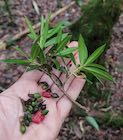Podocarpus buchii
Urb. 1924
Common names
Bois-lubin, coeur noir [Haitian French]; chicharron, tachuela [Spanish in Dominican Republic] (Mill 2015).
Taxonomic notes
Synonymy:
- Podocarpus angustifolius Griseb. subsp. buchii (Urb.) J.Staszk. var. buchii (Urb.) J.Staszk. 1988;
- Podocarpus aristulatis Parl. var. buchii Silba 2000 nom. inval.;
- Podocarpus aristulatus Parl. subsp. buchii (Urb.) Silba 2010.
See Podocarpus angustifolius for notes on phylogenetic relationships between the Caribbean species of Podocarpus.
Description
Dioecious evergreen tree 5-8(-20) m tall and 20-50(-100) cm dbh, with first-order whorled branches and an irregular, much-branched crown. Bark smooth, gray-brown when young (old bark not reported); inner bark reddish or purplish; wood pale yellow. Twigs densely arrayed, opposite in one plane or in flattened whorls of 3(-4), divergent at 45-70°, 30-130 mm long on juvenile trees but only 25-60 mm long on adult trees, greenish brown fading to gray-brown in later years. Terminal buds semiglobose, 2.5-3.5 × 2-3 mm. Bud scales 16-18, in three or four series, at most equalling diameter of bud, 2.3-5.4 × 1.1-1.6 mm, all overlapping, (brownish-) green, not keeled, tips erect, outer ones aristate. Leaves at flush reddish purple above and violet beneath, maturing glossy dark green or gray-green above, matte and similar or paler below; juvenile leaves usually slightly larger than adult. Leaves present on ultimate and penultimate branchlets, 2-12 mm apart, petiole 0-2 mm and twisted, leaf blade horizontally spreading or especially in juveniles slightly deflexed, diverging from axis at 58-88°, variably elliptic, 20-50 × 4.5-6 mm when juvenile, 15-35 × 4.2-8.7 mm when adult, 3-5 times as long as broad, thick, stiff, coriaceous, margins revolute; midrib 0.5-0.8 mm wide, without bordering striate bands beneath, conspicuously raised throughout its length below but only proximally above, obscure throughout above and usually not impressed in a groove; apex asymmetric, acute, sharply pungent-aristate, the arista 0.8-3 mm; base cuneate or short-attenuate. Pollen cones axillary, solitary, in groups of 1-3 per current-year twig, sessile, greenish yellow, cylindrical to ellipsoid, 10-16 mm × 2.1-3.5 mm. Pollen white. Seed cones solitary but usually in subopposite pairs, sessile or on a peduncle to 1.5 mm long. Receptacle formed of 1 sterile and 1 fertile bract, obovoid, herbaceous or only slightly fleshy when ripe, asymmetric, up to 6 mm long along longest edge, up to 4.5 mm along shorter edge, purplish red ripening red but the tips of both bracts pale green; bracts connate and fused except for free tips, glaucous. Epimatium gray-violet and very glaucous at when receptive, greenish and not glaucous when ripe, with several shallow longitudinal ridges. Seed 1, ellipsoid, laterally compressed, 7-8 × 5-5.5 mm, with apical crest. Leaf flushing and both pollen and seed cone receptivity coincide with the early May-June rainy season. Pollen cones are retained until ca. February and seed cones take ca. 12 months to ripen (Mill 2015).
This is the only Caribbean Podocarpus that can have leaves that are broadest below the middle; any small-leaved Caribbean specimen of the genus with ovate or lanceolate leaves is most likely to be this species. However, not all specimens have ovate or lanceolate leaves. P. buchii is one of two podocarps on Hispaniola; the other one, P. hispaniolensis, has a prominent groove on the upper leaf surface, terminal buds over 5 mm long, and pollen cones over 12 mm long. P. aristulatus differs in having larger leaves that are 35-60 mm long (Mill 2015).
Distribution and Ecology
Hispaniola, i.e. Haiti: Départements Centre, Artibonite, Ouest, Sud’est; and Dominican Republic: provinces Elias Piña, Barahona, Distrito Nacional / Santo Domingo, Independencia, Pedernales, La Vega, San José de Ocoa and near the border of La Vega and Santiago. Occurs on karst limestone and red clay soils, mainly on northern exposures, at elevations of 1100-2500 m; this typically places it at higher elevations than Podocarpus hispaniolensis. It grows in cloud forest as one of the dominant trees, together with Stenostomum oliganthum, Clusia clusioides, Schefflera tremula, Ditta maestrensis, and Magnolia pallescens. It is also a diagnostic species for the Hispaniola Montane and Upper Montane Pine Forest ecosystem, which also harbors Pinus occidentalis and Juniperus gracilior, and at high elevations (above 2000 m) it forms a woodland with P. occidentalis (Mill 2015 and sources cited therein).
Distribution data for all species native to the Caribbean, based on confirmed specimens cited by Mill (2015), using data from herbarium sheets. Data include both latitude/longitude and narrative location descriptions; coordinate uncertainty generally <5000 m. Podocarpus buchii shown in yellow.
The IUCN assesses P. buchii as "Endangered", primarily due to habitat loss from clearance for timber and agriculture, with additional losses due to fire and mining. The losses have been particularly extensive in Haiti. Moreover, habitat degradation is ongoing, including at sites within reserves; and the remaining habitat is severely fragmented. At some sites, particularly in the Dominican Republic, it has been described as “very common” and occurs in several protected areas, including the Parque Nacional Armando Bermúdez, Parque Nacional Juan Baotista Pérez Rancier, Parque Nacional Sierra de Bahoruco, and the Reserva Científica Ébano Verde. In Haiti, it occurs in La Visite National Park. Unfortunately, the "protection" afforded in these areas is not always effective, and could decline quickly if the responsibly governments so choose (Gardner 2013, Mill 2015).
Remarkable Specimens
No data as of 2023.01.14.
Ethnobotany
There are no recorded uses (Mill 2015).
Observations
See the sites mentioned in "Distribution and Ecology", above.
Remarks
The epithet honors Wilhelm Buch (1862-1943), Haitian pharmacist and plant collector, who collected the type specimen in September 1922 (Urban 1924, Mill 2015).
Citations
Gardner, M. 2013. Podocarpus buchii. The IUCN Red List of Threatened Species 2013: e.T191532A17311539. https://dx.doi.org/10.2305/IUCN.UK.2013-1.RLTS.T191532A17311539.en, accessed 2023.01.14.
Mill, Robert Reid. 2015. A monographic revision of the genus Podocarpus (Podocarpaceae): II. The species of the Caribbean bioregion. Edinburgh Journal of Botany 72(1):61-185. https://doi.org/10.1017/S0960428614000328.
Urban, Ignatz. 1924.02.20. Repertorium specierum novarum regni vegetabilis 19:298. Available: Real Jardín Botánico Biblioteca Digital, accessed 2023.01.14.
See also
No data as of 2023.01.14.



